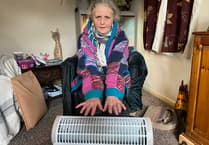An £11.4 million tech project which promises a ‘revolution’ in energy transmission is operating out of a secret site in a tiny Somerset village.
For months the community of Waterrow, between Wiveliscombe and Wellington, has played host to clean-tech firm Enertechnos during trials of its new ‘CTS’ cable, billed as both cost saving and carbon cutting.
Government data shows that the UK can lose as much energy in waste as it imports because of 'leaky cables.' Enertechnos estimates that this waste represents a cost of £100 to each household per year. CEO of Enertechnos Dominic Quennell said: "It's a problem worth solving."
The new cable was first installed in Waterrow, just before Christmas, where a team of highly specialised electrical engineers have been carrying out tests ever since.
As old electrical infrastructure comes to the end of its natural life, it will need to be replaced. Enertechnos hope their new energy saving cable will be rolled out across the country and beyond.

The patented cable technology saves energy by insulating the interior copper elements. Mr Quennell explained: "The only thing that we’ve changed is the inside. What we’ve done is we’ve changed the electrical property of what’s going on inside the cable.
"There’s a device called a capacitor, normally a capacitor is used to store energy briefly and then it discharges it suddenly so it overcomes torque when you want to start a motor or something. By using the capacitors we have in here we balance out another electrical feature which is called reactants."
Data from Consumer Futures shows that 1.5 per cent of the UK's carbon output are accounted for by energy lost in transmission across the power network. Mr Quennell says Enertechnos' cable can minimise that loss, and use less carbon-intensive copper in the process: "We can carry power further distances between the generator point and the point of consumption and we can do it with less copper. "The less copper bit is very important because it’s very expensive and it has a very high carbon cost. Every tonne of copper that you make, you release six tonnes of C02 into the atmosphere.
The third thing is a little after 2030, on current projections there is going to be quite a big delta between the amount of copper we can produce and the amount of copper we are going to need."

Enertechnos have had a team of electrical engineers from Surrey working one week on and one week off, boarding at a local hotel. Mr Quennell said: "It's the perfect place to test. We chose this location because it’s very quiet, we’re not disturbing anybody and we can get about our business flying under the radar. Where we are as our main office in South West London you can’t find anywhere that you can do this.
"We’ve been enjoying it and the guys, they’re thrilled to get out of London and stay in a nice country pub, it’s been great. Everyone’s been very friendly and it’s a great atmosphere.
"With the results we’re getting here we’re demonstrating how it compares and contrasts with conventional cable. That gives us data that we can take to everybody from the distribution network operators who own all of the local distribution grid, Ofgem, government departments."
Comparing the cable design process to the Apollo 13 oxygen tank accident, Mr Quennell said: "The evolutionary aspect of it is that it looks like a regular cable – we had to make it this way – all of the DNOs, the distribution network operators have people who are trained to install cable.
"So the joints have to be familiar to the installers. One of the DNOs we spoke to said ‘we’d love to do it’ but we’re only allowed two extra tools in the kit. So we had to design a cable that could be produced, a bit like Apollo 13 when the guy tips the box over, they had 3 guys in space dying of oxygen deprivation so they had a certain amount of stuff in the capsule they were sitting in.
"Back on land one the engineers tipped out a box of stuff and said ‘you can do whatever you like but you can only do it with this’ and that’s practically what the DNO said to us. These are the tools you can have plus two more."

Visiting the site on March 24, Labour frontbencher Alan Whitehead, who has a portfolio in green energy, said: "We’re putting a lot more power in to the system than we’re getting out so if you can get more efficient in terms of how much energy is lost in transit, you’ve done yourself rather a favour in terms of the overall efficiency of the system – it gets you a lot more for a lot less.
"I say to myself no transition without transmission whereby we’re not going to get to a low carbon future unless we have the wherewithal to deliver it.
"We’re standing in a portable building in the middle of a field but this is actually potentially very big. This is just the sort of thing you need to us to where we want to be, and hopefully this will be all sorted out and proved and ready to go in time for that explosion of cabling we’re going to have to put in."
Work is set to continue on the Waterrow site for some months as Enertechnos continue their testing operations.




